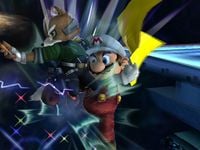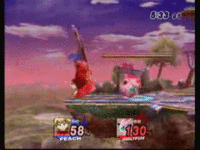
Edge-guarding, or edgeguarding, is the attempt to prevent an off-stage recovering enemy from reaching the stage. Players can achieve this in many ways, and the struggle between an edge-guarder and their enemy leads to many strategies and mindgames. The anti-strategy is the guard break.
General information
Edgeguarding is a very useful technique in which a player attempts to prevent the foe from getting back to the stage or grabbing the edge.
There are two main methods of edgeguarding. One is to run or jump off the stage and attack; this is often done by characters with great jumping ability, which includes multiple jumps and good recoveries such as the Robo Burner. The other is to stay on the stage and attack the opponent when they recover should they fail to sweetspot the ledge. This is mostly done with down- smashes and tilts, and even some projectiles.
Any character can edgeguard, although some are better at it than others. A great example of edgeguarding is Fox's down special in mid-air. The player jumps off the stage, hits the opponent with a shine as they recover, jumps quickly to cancel the lag and recovers onto the stage. This is known as Shine Spiking.
Certain characters are worse at defending themselves from edgeguards. These generally consist of characters with predictable recoveries (like Captain Falcon or Ike), slow recoveries (like Ness or Lucas), characters reliant on tether recoveries (like Olimar or Ivysaur), or characters without a damaging recovery move (like Lucario).
In Brawl, the best recoveries are much better than in Melee. For example, a decent Meta Knight player is near impossible to edge-guard due his large amount of options which puts opponents at a very high risk if they try to edge-guard him. This is also since hitstun is low in Brawl so it is very possible for MK to be hit by an edgeguard and be able to hit the opponent before they get back on stage. The auto-edge sweetspot mechanic in Brawl aids this even further.
The opposite applies for the majority in Smash 64. With the exception of Pikachu and to a small extent Mario, most of the cast has a predictable recovery. This is also since hitstun is very high so it is somewhat easy to combo someone when they get back on stage to continuously edgeguard them. Also, this is since ledge-teching wasn't introduced yet (outside of massive ledge smash DI).
Melee can be considered in the middle in this regard. Due to the ability to tech, most moderate recoveries in melee tend to be quite good if the other person is good at teching. Jigglypuff is considered to be the hardest to edgehog in Melee as is Meta Knight in Brawl; since both have great aerial moves, it is especially difficult to keep them away from the edge, and thanks to their multiple jumps, it's even harder to hog it.
Edge-guarding strategies
On-stage guarding
The simplest and safest way to edge-guard is to stand at the edge and throw attacks - often a powerful forward smash, down smash or down tilt that can hit even an edge sweet spotting enemy. While this method of edge-guarding requires the least set-up, it is often thwarted by sweet-spotting or ledge-teching.
Using projectiles
In a similar strategy to sitting on stage, a character with projectiles (especially projectiles affected by gravity, like Peach's turnips or Mario's fireballs) can stand by the edge and try to interrupt a faraway, recovering opponent. This strategy is very safe, in that players are very unlikely to be hit while edge-guarding in this fashion, and it can be combined with both edge-hogging and attacking from on-stage.
Off-stage guarding
A risky, but deadly, way of edge-guarding is to jump off-stage and interrupt the opponent in mid-air. The recovering enemy has few options by which they can defend themself, such as using aerial attacks, air dodging (in Brawl only) or directing themself away from the edge-guarder. When using this style of edge-guarding, most characters put their own life in jeopardy, being so far off-stage. If, however, the edge-guarder is able to land a powerful aerial attack (like Captain Falcon's Knee Smash) far off-stage, their enemy will almost certainly get KOed. Even if unsuccessful, the edge-guarder can often edge-hog the recovering opponent anyways.
With most characters, it is best to avoid using the second jump before hitting the opponent. Many characters will not be able to make it back without it. Characters such as Jigglypuff, Kirby, and Meta Knight are very useful characters to use for this strategy. Their multiple second jumps allow them to go far off stage and deliver a aerial attack.
Edge-hogging
A common way to edge-guard is to edge-hog, or grab the ledge so that the opponent cannot. There are several ways to reach the ledge when standing on-stage. The two most common ways are to face away from the ledge and either short hop or wavedash backwards. Many players, when wavedashing backwards, make the mistake of standing too close to the edge before wavedashing, thereby air dodging off-stage and self-destructing. Note also that with some characters, it is possible to fast-fall the wavedash off the stage and in effect grab the edge sooner.
Usually, an edge-hogger rolls the moment the recovering enemy uses their third jump, gaining invincibility frames and defending themself against damaging up special moves. Edge-hogging is effective against sweet-spotting, but can be beaten by an enemy that comes fully on-stage in their recovery.
When an enemy lands fully on-stage they are often caught in the lag of their third jump. Edge hopping is often the method to keep them off the stage. This causes one to return to the starting position of choosing which edge guarding technique to use, but the opponent has slightly more damage, leading to a constant edgeguard game.
Deterrence
A somewhat underutilized ability, deterrence is basically fake off-stage guarding. The player would make to jump towards the opponent trying to recover, but instead return to the stage without ever engaging the enemy. If done convincingly, the opponent will attempt to evade the non-existent attack and hopefully miss the ledge or dodge right into a different attack.
While this strategy works against newer players, it usually requires a twist against more advanced combatants. In this case, doubles play is usually necessary. One possible strategy involves Marth attempting a spike on an oncoming enemy from an above platform, while having Roy charge a Flare Blade below. From here, one of four things happen: 1) Marth connects the spike and KO's the enemy; 2) Marth spikes the enemy into Roy's Flare Blade; 3) in attempting to evade Marth's spike, the enemy lands in the hitbox of Roy's Flare Blade; or 4) in attempting to evade both attacks, the enemy completely misses the edge.

